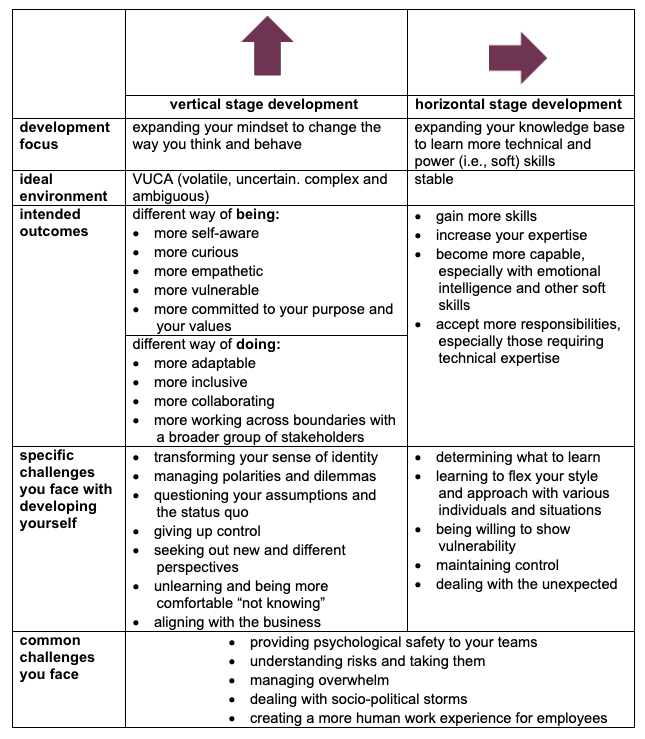 “Grow up!” This phrase has new meaning to me this year now that I’ve started to study vertical stage development to grow leaders.
“Grow up!” This phrase has new meaning to me this year now that I’ve started to study vertical stage development to grow leaders.
Vertical stage development is more about an individual’s personal growth and less about the skills an individual acquires and polishes.
To say it another way, with vertical stage development, you move away from what you know. And you move toward how you make sense of the knowledge and wisdom you have and are applying.
Vertical stage development is easier to understand when you contrast it to horizontal stage development. This table compares the two approaches.

Based on these differences, vertical stage development is much more complex and nuanced than horizontal development. Many coaches, including myself, work with leaders to adjust their mindset to think and behave in different ways. However, speaking for myself, I’ve not been doing this in the systematic way the vertical stage development academics and experts suggest.
As for horizontal development, it typically involves signing up for a class or workshop, showing up, and then checking off the box after you’ve taken it. Practicing what you learned is basically up to you, unless you’re working with a coach or others to keep you accountable or preparing to pass exams to acquire and maintain credentials.
The complexity of vertical development is one of the many reasons why most organizations stick with horizontal development. Many senior leaders and board members recognize they’re lax in building a strong pipeline of leaders for their current environment, much less the future. However, they continue to stick with the status quo for developing leaders.
Last year consultants and professors, Julie Chesley, Terri Egan and Suzanne Lahl published their research paper, Helping Leaders Grow Up: Vertical Leadership Development in Practice. They found that senior leaders have been unwilling to devote time, money and resources to three key practices that help vertical development take root in organizations.
To prosper, vertical development needs senior leaders to 1) invest and sponsor in vertical development, 2) role model how to work with a different mindset, and 3) embrace vertical development with their words and actions.
The researchers learned that vertical development benefits from several other attributes too. These include a stable of coaches and other practitioners who deeply understand vertical development, an environment of openness, vulnerability and risk taking, and several business processes.
If you’re interested in learning more about vertical development, start with this research paper. You also can read books.
Robert Kegan, the Harvard University Professor of Adult Learning and Professional Development has been exploring this field for many years. His 1998 book In Over Our Heads: The Mental Demands of Modern Life is a classic.
More recently, Kegan wrote An Everyone Culture: Becoming a Deliberately Developmental Organization with his longtime collaborator, Lisa Laskow Lahey. The authors propose that organizations prosper best when they focus on creating an organizational culture that supports the growth and development of all employees. (After reading this book with a group of college seniors, I wrote this blog How to develop people to grow profits.)
Another book is Leadership Agility: Five Levels of Mastery for Anticipating and Initiating Change by Bill Joiner and Stephen Josephs. I read this research-based book earlier this year with several other telos institute coaches and consultants. The book is on the dry side yet is packed with helpful real-life stories and examples. Our group discussions helped bring out the book’s key points.
These books won’t make you an expert in vertical stage development. However, they will open your eyes and show you the possibilities it offers, especially for our VUCA world.
When you grow up rather than out, you’re able to acknowledge your inability to live and work in a bubble that you control. Instead, you’re able to notice all the shifting around you. Your experiences balancing and dealing with the current state better equips you to consider how you want to shape your preferred future for yourself and others.

0 Comments